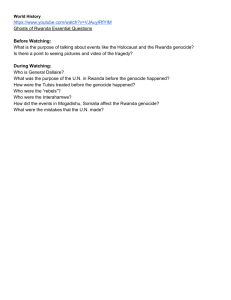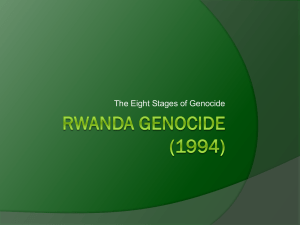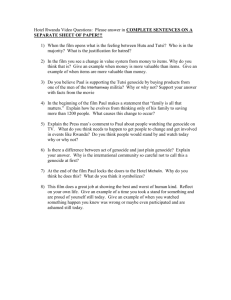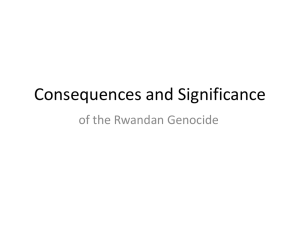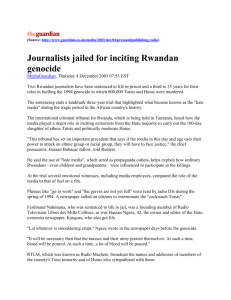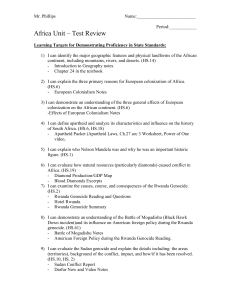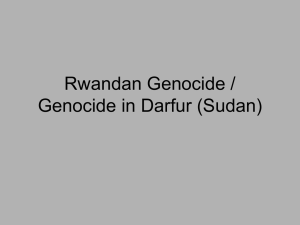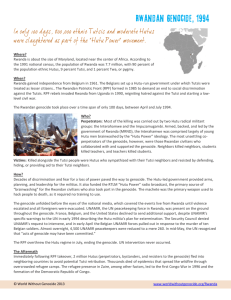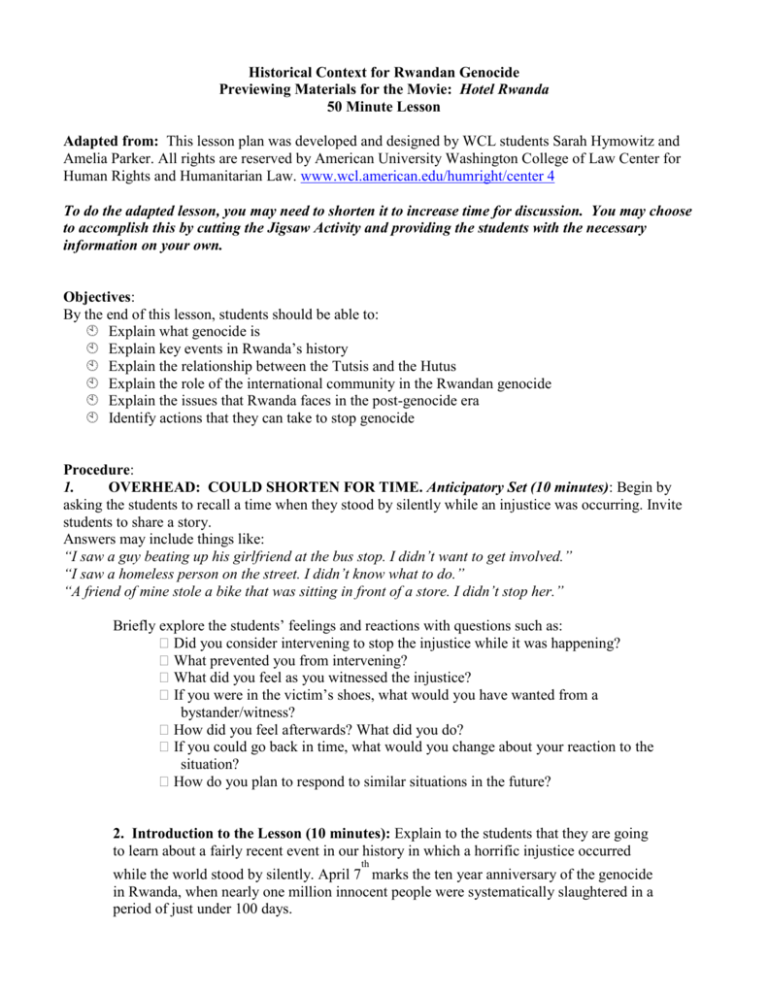
Historical Context for Rwandan Genocide
Previewing Materials for the Movie: Hotel Rwanda
50 Minute Lesson
Adapted from: This lesson plan was developed and designed by WCL students Sarah Hymowitz and
Amelia Parker. All rights are reserved by American University Washington College of Law Center for
Human Rights and Humanitarian Law. www.wcl.american.edu/humright/center 4
To do the adapted lesson, you may need to shorten it to increase time for discussion. You may choose
to accomplish this by cutting the Jigsaw Activity and providing the students with the necessary
information on your own.
Objectives:
By the end of this lesson, students should be able to:
Explain what genocide is
Explain key events in Rwanda’s history
Explain the relationship between the Tutsis and the Hutus
Explain the role of the international community in the Rwandan genocide
Explain the issues that Rwanda faces in the post-genocide era
Identify actions that they can take to stop genocide
Procedure:
1.
OVERHEAD: COULD SHORTEN FOR TIME. Anticipatory Set (10 minutes): Begin by
asking the students to recall a time when they stood by silently while an injustice was occurring. Invite
students to share a story.
Answers may include things like:
“I saw a guy beating up his girlfriend at the bus stop. I didn’t want to get involved.”
“I saw a homeless person on the street. I didn’t know what to do.”
“A friend of mine stole a bike that was sitting in front of a store. I didn’t stop her.”
Briefly explore the students’ feelings and reactions with questions such as:
� Did you consider intervening to stop the injustice while it was happening?
� What prevented you from intervening?
� What did you feel as you witnessed the injustice?
� If you were in the victim’s shoes, what would you have wanted from a
bystander/witness?
� How did you feel afterwards? What did you do?
� If you could go back in time, what would you change about your reaction to the
situation?
� How do you plan to respond to similar situations in the future?
2. Introduction to the Lesson (10 minutes): Explain to the students that they are going
to learn about a fairly recent event in our history in which a horrific injustice occurred
th
while the world stood by silently. April 7 marks the ten year anniversary of the genocide
in Rwanda, when nearly one million innocent people were systematically slaughtered in a
period of just under 100 days.
3. MARY’S STUDENTS ALREADY SHOULD KNOW THIS, SO JUST ASK
THEM TO REVIEW WHAT GENOCIDE IS. Before delving into the specifics of
Rwanda, ask the students how they would define genocide. Write down on the board key
words they say in defining genocide.
Explain that genocide is the systematic extermination of a group of people on the basis of
a defining characteristic.
Suggest that genocide has a few specific components [write them on the board]:
� Acts committed
� With the intent
� To destroy (in whole or in part)
� A group of people
� Based on a specific characteristic of the group (such as race, religion, ethnicity)
th
Now ask the students to name examples of genocide in the 20 century (answers may
include: the Holocaust, Armenia, Cambodia, Bosnia). Ask whether they know of any
countries today in which the threat of genocide loom (Sudan, Chechnya).
Explain that after World War II and the Holocaust in which 6 million Jews were
systematically murdered in concentration camps by the Nazis, the international
community decided that this should never happen again. They adopted the Genocide
Convention which gives a legal definition of genocide and which obligates the countries
that sign the treaty to intervene to stop genocide when it is occurring.
4. OVERHEAD: The legal definition of genocide as defined by the Genocide
Convention is:
“[A]ny of the following acts committed with intent to destroy, in whole or in part, a
national, ethnical, racial or religious group, as such:
• Killing members of the group;
• Causing serious bodily or mental harm to members of the group;
• Creating living conditions of the group with the intent to bring about its
physical destruction in whole or in part
• Imposing measures intended to prevent births within the group;
• Forcibly transferring children of the group to another group”
~ Convention on the Prevention and Punishment of the Crime of Genocide, Article 2
5. OVERHEAD: Introduce Rwanda: Rwanda is a small country in central Africa. It is
the most densely populated country in Africa. It is populated by two major ethnic groups:
the Hutus and the Tutsis. Ten years ago, after a long process of planning and preparation,
the Hutu majority launched an intense period of systematic killings of friends, neighbors
and schoolmates, murdering mostly Tutsis and some moderate Hutus. In less than one
hundred days, nearly one million people were killed. That is nearly twice the entire
population of Washington, DC.
6. Jigsaw Activity (25 minutes):
1. Have the students count off 1-2-3-4-5-6 and divide them into six groups. Each
group should be given the appropriate packets of material. There should be
one copy for each person in the group. Explain to the students that they will
read the material to become “experts” on a particular aspect of the Rwandan
genocide – the history of the Hutus/Tutsis, the reality of genocide in Rwanda,
the international response, and post-genocide Rwanda. When the groups are
rearranged, they will be asked to teach their classmates about the particular
aspect of the genocide that they are studying in these small groups.
2. Give the students 10 minutes to read through the material and look at the
accompanying pictures/maps/illustrations.
3. When they are finished reading, ask each group to discuss the Review
Questions on the last page of their packets. This should take an additional five
minutes. [The teacher should circulate to each of the groups.] OR SHOULD
WE HAVE THEM DO T-NOTES AND SHARE WITH OTHER
GROUPS?
4. Now re-group into small groups of six by having the members of each of the
three large groups count off. Make sure that at least one student from each of
the three large groups is now with one person from each of the other groups.
5. Using the “Talking Points” found on the last page of their packets as a guide,
have each student teach the other students what they learned in their “expert”
group. The order of the discussion, which will take about 10 minutes, should
proceed as follows:
a. History of the Tutsis and Hutus
b. International Response
c. Post-Genocide Era
7. Wrap-Up Discussion (5 minutes):
To begin the conclusion of the lesson, ask the students the following questions:
� What can we learn from the genocide in Rwanda?
� Have we learned these lessons?
Supplemental Materials:
1.
2.
3.
4.
5.
Student Handout—Pre-Viewing Material for Hotel Rwanda
*Includes short paragraph about what happened in Rwanda in 1994, map and movie
review.
Jigsaw Packet for Group 1: History of the Tutsis and the Hutus
Jigsaw Packet for Group 2: International Response to the Genocide
Jigsaw Packet for Group 3: Post-Genocide Rwanda
The Rwanda Commemoration Project: Genocide in Our Time
*Includes “First They Came for the Jews” poem by Pastor Martin Niemoller and information on
actions students can take to help stop the atrocities and reduce the suffering of the Darfurian
people (Sudan).
This lesson plan was developed and designed by WCL students Sarah Hymowitz and Amelia Parker. All
rights are reserved by American University Washington College of
Law Center for Human Rights and Humanitarian Law. www.wcl.american.edu/humright/center 4
Rwandan Genocide
Pre-Viewing Material for Hotel Rwanda
Rwanda is a small country in central Africa. It is the most densely populated country in Africa. It is
populated by two major ethnic groups: the Hutus and the Tutsis. Ten years ago, after a long process of
planning and preparation, the Hutu majority launched an intense period of systematic killings of friends,
neighbors and schoolmates, murdering mostly Tutsis and some moderate Hutus. In less than one hundred
days, nearly one million people were killed. That is nearly twice the entire population of Washington, DC.
The legal definition of genocide as defined by the Genocide Convention is:
“[A]ny of the following acts committed with intent to destroy, in whole or in part, a national, ethnical,
racial or religious group, as such:
• Killing members of the group;
• Causing serious bodily or mental harm to members of the group;
• Creating living conditions of the group with the intent to bring about its physical destruction
in whole or in part
• Imposing measures intended to prevent births within the group;
• Forcibly transferring children of the group to another group”
~ Convention on the Prevention and Punishment of the Crime of Genocide, Article
Hotel Rwanda (2004)
U.S. Rating PG-13
The MPAA rated Hotel Rwanda (2004) PG-13 on appeal for violence, disturbing images
and brief strong language..
During an approximate 100-day period in 1994, while North Americans were fixated on
making money in a new economic age, the African country of Rwanda was home to an
atrocity that would eventually set itself in history as one of the largest genocides on the
planet.
For those unfortunate masses in the midst of this unfathomable mayhem, all hope was lost when first-world
governments turned their backs on the situation. In Hotel Rwanda, the lens focuses on what may be the only bright
spot in this debacle: The efforts of hotel manager Paul Rusesabagina (Don Cheadle)--who is identified as a Hutu
himself --to save over 1,200 people from the murdering machetes of the Hutu militia.
Compared to its surroundings, the Belgian-owned Hotel Mille Collines was an opulent oasis where UN dignitaries
and western media congregated, drinking highballs while enjoying melodies from the grand piano. Even prior to the
massive murders, maintaining this fragile façade of luxury took all of the creative talents Rusesabagina could
muster. For instance, when half a shipment of two-dozen lobsters arrived dead, the crafty manager told the cook to
create a new menu item by filling the shells with other foods.
But the sounds of fighting outside the hotel complex are getting louder as militant Hutus begin their selective
targeting of all people identified as Tutsis. Now the pampered White guests will have to face the inevitable reality:
War is on the doorstep and the Heineken beer will run out soon. Piling into buses that will usher them out of the
coming hell, the locals are left to fend for themselves.
The one exception is Colonel Oliver (Nick Nolte), a Canadian soldier in charge of UN peacekeeping duties…
despite of having his contingent cut back to virtually nothing. (Oliver is a fictional character based upon real life
Canadian Romeo Dallaire, who oversaw the meager UN peacekeeping process throughout Rwanda.) Like the story
of the boy who sticks his finger in the dyke to stop the flood, Oliver's task is virtually impossible.
Eventually Rusesabagina's home is surrounded by violence, forcing him to move his family and friends into the
hotel. The group consists of a mixture of Hutu and Tutsi moderates, including his wife Tatiana (Sophie Okonedo)
who is recognized as a Tutsi. Although cut off from food and water, with the rooms and hallways bursting with
humanity, the phone lines are, amazingly, still operating. Imploring his many influential guests to make calls to the
outside world and plead for help, Rusesabagina hopes someone will finally take notice of their plight.
The movie, in an effort to provide a small inkling of the real-life horror, depicts many bloodied corpses. In one
scene, when Rusesabagina and his assistant are driving through fog, they think they've driven off the road. Instead,
they discover the bumpy surface is paved with the bodies of the slaughtered. Other situations show people about to
be killed with the Hutu's favorite weapon, a machete, but edits prevent us from seeing the actual carnage. Later, we
briefly see women in underwear and others who are possibly naked, kept within a fence. It is insinuated they have
been raped.
Best described as Africa's version of Schindler's List, this film does stop short of showing the atrocities in explicit
detail--this decision was made to assure a PG-13 rating and allow it to be viewed by a larger audience. However,
parents (and teachers) should carefully prescreen this film before presenting it to teens. This is a haunting movie,
sure to disturb many-but with good reason. Hopefully it will allow us to recognize the consequences of our reaction
to this event.
Moving and timely, Hotel Rwanda skillfully illustrates how media can be used to bring attention to situations that
should never be overlooked again.
Official Website...
http://www.mgm.com/ua/hotelrwanda/intro.html.

